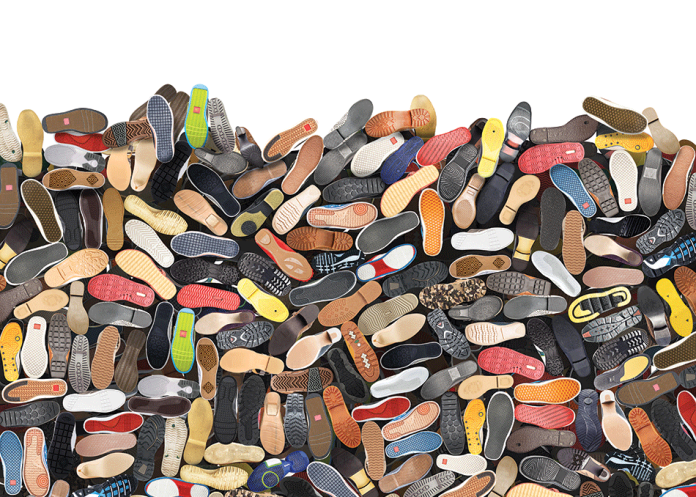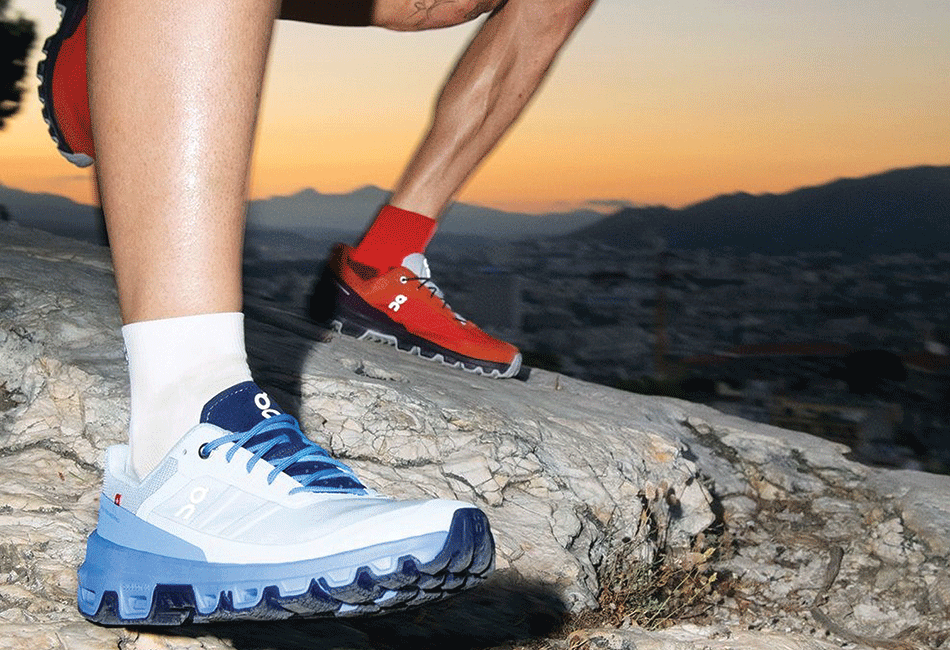By Patrick Reichert and Oscar Vosshage
Sneakers (or “trainers”, as they are known in the UK) are big business – and leave a heavy environmental footprint. But new business models are looking to disrupt the footwear industry and bring sustainable change through the combination of material innovation and product-as-a-service subscriptions.
In 2022, global footwear market revenue reached $381 billion, with estimates that it will eclipse $450 billion by 2027.1 But of the 23 billion pairs of shoes manufactured every year, 90 per cent are believed to end up in landfill.2 And once in a landfill, it takes between 30 and 40 years for just one pair to decompose, and a common sneaker midsole made from ethylene vinyl acetate (EVA) can last up to 1,000 years.3
Wedged between rapid industry growth and mounting concern over the industry’s environmental impact, bids for sustainability riff on the basics: material innovation, clean-tech-enabled manufacturing, transparent supply chains, and circular design models.
Looking to crack the code of sustainable footwear, Swiss running brand On4 is the latest athletic apparel company to enter the race – with one notable difference: its Cyclon product line will feature fully recyclable shoes, made chiefly from castor beans, and is only available via a monthly subscription. Through the combination of material and business model innovation, On believes it could be on the verge of a closed-loop product life cycle, ushering in a truly circular and sustainable footwear market.
The shoe you will never own
For $29.99 a month, On’s subscription model allows consumers to send back their worn-out shoes and receive new ones. The Cloudneo5, On’s first footwear under the Cyclon product line, is engineered for approximately 600 km, the average distance a dedicated runner covers in about six months, translating to roughly two pairs per year.
Driving sustainability through material innovation
Most footwear is made from problematic materials like nylon, synthetic rubber, and plastic. They are shaped by energy-intensive processes such as injection moulding, foaming, and heating, and then bound together with environmentally damaging chemicals.
On’s Cloudneo uses an innovative material called Pebax Rnew from Arkema SA (a French speciality materials company), which is derived from castor beans. Pebax Rnew can be modified during processing to provide bounce in the sole, as well as comfort and support in the upper. In other words, it is the only material used in the Cloudneo, thus reducing complexity in recycling.
In addition to using this new material, On has an internal life cycle assessment (LCA) team working to quantify the environmental impacts of the new programme. The On company estimates that a pair of Cloudneos generates 20 to 30 per cent less carbon dioxide than the 18 kilograms emitted by a typical pair of its shoes, but the benefit could increase if the proportion of recycled material rises over time.6
Closing the loop through business model innovation
Ultimately, On wants to achieve full circularity, so that discarded clothing items are completely reused to create new ones. Potentially by the end of the decade, On executives aim to bring back 90 per cent of its products for recycling.7 But, as other brands have explored this vision, they’ve hit roadblocks. For example, in 2018, Adidas released the Futurecraft.Loop, a “100 per cent recyclable” performance running shoe. Yet soon after its launch, Adidas publicly shared that its Futurecraft.Loop pilot struggled (reaching only a 10 per cent recycle rate), because consumers wouldn’t send the shoes back in time for Adidas to generate the next batch and keep the circle in motion.8
Redesigning the way consumers “purchase” shoes could be the key to closing the circularity loop. According to François-Xavier Dosne, On’s head of innovation business strategy, “The hurdle to circularity [that’s] facing the industry is that people are not sending shoes back to recycle them… The subscription automates that process.”9
By selling kilometres used rather than shoes, On shifts its sales incentive from selling as many shoes as possible to making shoes last as long as possible. This transformation can be likened to Michelin tyres’ performance-based model, where the company focuses on maximising the tyres’ lifespan and efficiency rather than the quantity of tyres sold.10
The subscription model offers customers convenience and potential savings. With less decision-making and hassle, customers can focus on enjoying their shoes, knowing they will be replaced when worn out.
Circular economy or subscription fatigue?
The unique combination of material and business model innovation could give On a leg up in the sustainable-footwear wars. However, competition is fierce, with industry frontrunners like Adidas and emerging startups like Allbirds, who are also developing more sustainable shoes. In addition to its Futurecraft.Loop programme, Adidas teamed up with the NGO Parley for the Oceans in 2015 to release the first performance shoe with an upper made from marine plastic waste and illegal deep-sea gillnets (fishing nets that are hung vertically so that fish get trapped by their gills).11 In terms of pure carbon footprint, Allbirds recently unveiled M0.0nshot, a sneaker with a net footprint of 0.0 kg of CO2 emissions. Rather than achieving this feat through controversial carbon offsetting, the shoe relies on three materials that Allbirds says are carbon-negative: regeneratively farmed merino wool, a sugarcane-based EVA foam, and a bioplastic made from methane by US startup Mango Materials.12
Faced with several sustainable-footwear options, On’s subscription model risks only appealing to power users or consumers willing to pay a premium. Keep in mind that On’s assertion of “wearing the shoes out” involves running an ambitious 25km per week – a significant commitment for many casual runners. At 25 km per week, On’s Cloudneo would retail at $180, translating to an economical $0.30 per kilometre, well in the range of their closest (non-sustainable) competitors, the Nike Infinity at $0.23/km13 and Adidas Fresh Foam at $0.26/km.14 However, any delay in reaching the 600km lifecycle can turn into a costly affair. Each additional month drives up the cost by $0.05 per km, with customers footing the bill.
 Despite the initial hype, it’s important to recognise that circular subscription models are still in the early stages of experimentation. Nevertheless, circular subscriptions are rapidly becoming commonplace across several consumer goods categories. Mud Jeans has launched its “Lease A Jeans” programme15, Swapfiets identifies as a “bicycle as a service” company16, and Fernish offers rentable, maintained furniture. But given the rise of subscription fatigue, it remains to be seen how many subscriptions consumers are willing to spring for. Nevertheless, the race for sustainable consumer products is on and may well be shaped by transforming consumption habits towards circular subscriptions.
Despite the initial hype, it’s important to recognise that circular subscription models are still in the early stages of experimentation. Nevertheless, circular subscriptions are rapidly becoming commonplace across several consumer goods categories. Mud Jeans has launched its “Lease A Jeans” programme15, Swapfiets identifies as a “bicycle as a service” company16, and Fernish offers rentable, maintained furniture. But given the rise of subscription fatigue, it remains to be seen how many subscriptions consumers are willing to spring for. Nevertheless, the race for sustainable consumer products is on and may well be shaped by transforming consumption habits towards circular subscriptions.
About the Authors
 Patrick Reichert, Associate Director and Research Fellow at the elea Chair for Social Innovation, IMD. Patrick conducts research at the intersection of entrepreneurship, finance, and social impact, with a particular focus on the mechanisms and practices that investors use to seed investment in social organisations. He is the associate director at the elea Chair for Social Innovation.
Patrick Reichert, Associate Director and Research Fellow at the elea Chair for Social Innovation, IMD. Patrick conducts research at the intersection of entrepreneurship, finance, and social impact, with a particular focus on the mechanisms and practices that investors use to seed investment in social organisations. He is the associate director at the elea Chair for Social Innovation.
 Oscar Vosshage, Research Associate Intern at the elea Center for Social Innovation, Masters Student E4S. Oscar is a Master of Science in Sustainable Management and Technology candidate at E4S, a joint master programme of IMD, EPFL and UNIL. He is also project lead for a Lausanne Global Shaper project aiming to raise awareness of the heart attack gender gap.
Oscar Vosshage, Research Associate Intern at the elea Center for Social Innovation, Masters Student E4S. Oscar is a Master of Science in Sustainable Management and Technology candidate at E4S, a joint master programme of IMD, EPFL and UNIL. He is also project lead for a Lausanne Global Shaper project aiming to raise awareness of the heart attack gender gap.
References
- https://www.statista.com/forecasts/976367/footwear-market-size-worldwide#:~:text=In%202022 percent2C%20the%20global%20footwear,billion%20U.S.%20dollars%20by%202027
- https://www.theguardian.com/fashion/2020/mar/21/some-soles-last-1000-years-in-landfill-the-truth-about-the-sneaker-mountain
- https://www.theguardian.com/environment/2009/aug/23/repair-trainers-ethical-living
- https://www.on-running.com/en-us/
- https://www.on-running.com/en-us/products/cloudneo-42cloudneo/mens/undyed-shoes-42.98711?queryID=ff59d7717fd3e5649f3eea3135a7d080
- https://www.wsj.com/articles/the-100-recyclable-running-shoe-thats-only-available-by-subscription-11657188000
- https://www.wsj.com/articles/the-100-recyclable-running-shoe-thats-only-available-by-subscription-11657188000
- https://qz.com/quartzy/1747230/adidas-says-it-successfully-recycled-its-first-batch-of-futurecraft-loop-sneakers
- https://www.fastcompany.com/90850232/on-creates-circular-system-to-recycle-running-shoes
- https://www.iotworldtoday.com/iiot/a-look-at-michelin-s-product-as-a-service-strategy
- https://news.adidas.com/running/adidas-and-parley-for-the-oceans-unite-sporting-communities-across-the-globe-to-run-for-the-oceans/s/0621eb8e-fe22-426f-8bf3-4980347c184f
- https://www.voguebusiness.com/sustainability/allbirds-says-its-net-zero-carbon-shoe-is-here
- https://www.solereview.com/nike-react-infinity-run-flyknit-3-review/
- https://www.solereview.com/new-balance-fresh-foam-1080-v12-review/
- https://mudjeans.eu/pages/lease-a-jeans
- https://swapfiets.com/
- https://fernish.com/




































